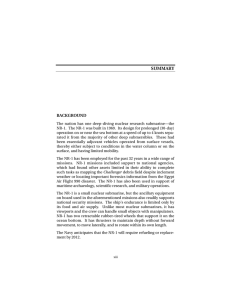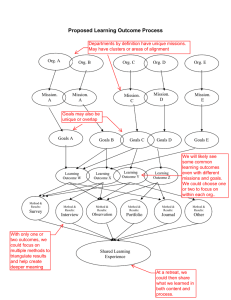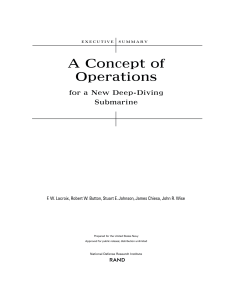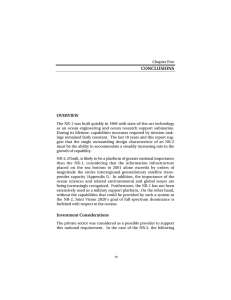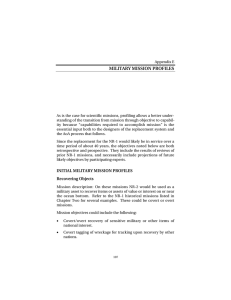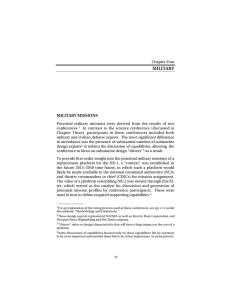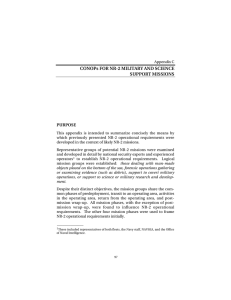INTRODUCTION REPORT
advertisement
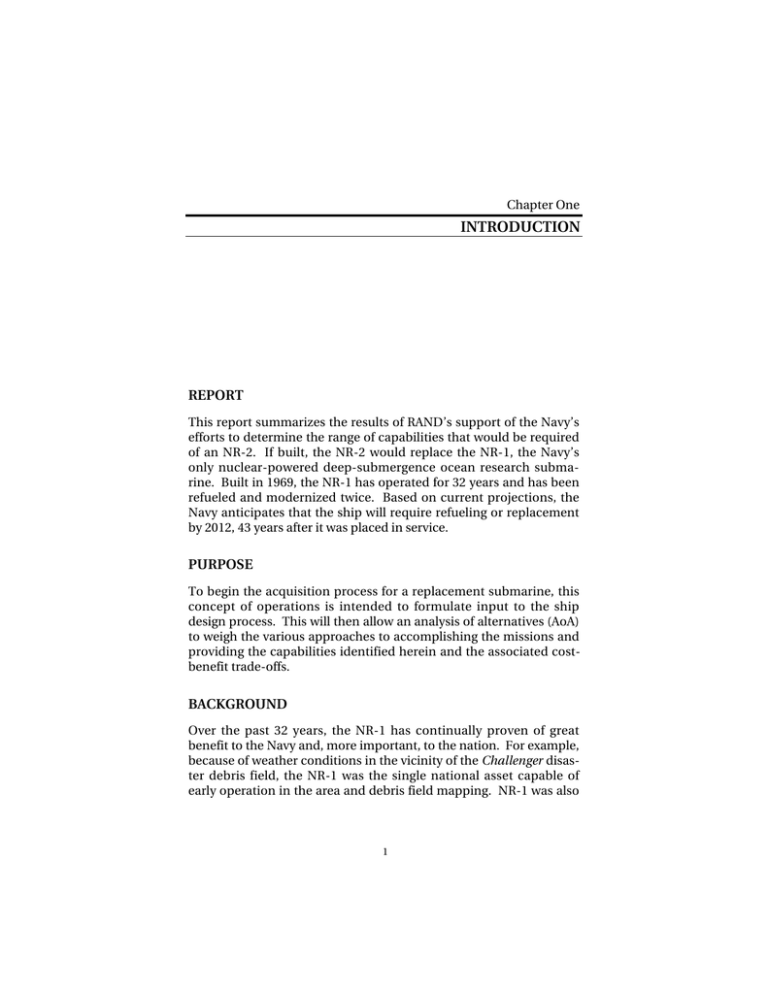
Chapter One INTRODUCTION REPORT This report summarizes the results of RAND’s support of the Navy’s efforts to determine the range of capabilities that would be required of an NR-2. If built, the NR-2 would replace the NR-1, the Navy’s only nuclear-powered deep-submergence ocean research submarine. Built in 1969, the NR-1 has operated for 32 years and has been refueled and modernized twice. Based on current projections, the Navy anticipates that the ship will require refueling or replacement by 2012, 43 years after it was placed in service. PURPOSE To begin the acquisition process for a replacement submarine, this concept of operations is intended to formulate input to the ship design process. This will then allow an analysis of alternatives (AoA) to weigh the various approaches to accomplishing the missions and providing the capabilities identified herein and the associated costbenefit trade-offs. BACKGROUND Over the past 32 years, the NR-1 has continually proven of great benefit to the Navy and, more important, to the nation. For example, because of weather conditions in the vicinity of the Challenger disaster debris field, the NR-1 was the single national asset capable of early operation in the area and debris field mapping. NR-1 was also 1 2 A Concept of Operations for a New Deep-Diving Submarine used as a national asset following the October 2000 crash of Egypt Air Flight 990. The scientific community has used NR-1 extensively in the area of deep-ocean research and other fields. On the other hand, although the NR-1 is a unique Navy asset, it has not been tasked extensively as a military asset, and the future will hold both additional opportunities and challenges for a vessel like NR-1 if it is assigned more routinely to military operations. STUDY PURPOSE Identifying and prioritizing those scientific, military, and support missions that would likely be assigned to the NR-2 over its planned operational life can clarify concepts of operation for the NR-2. Along with those concepts, mission priorities can then be clarified to prioritize the operational capabilities of NR-2. SOURCES Our assessment was based primarily on the inputs of the expert participants in three conferences. These were to a large extent operational, scientific, academic, and national security experts. In operational assessments, we weighted most heavily the inputs provided by the former officers-in-charge (OICs) of NR-1. To mitigate potential biases, expert participants included military and scientific personnel familiar with alternative methods of accomplishing missions. In addition, following the conferences, RAND consulted additional outside sources familiar with alternative methods. METHODOLOGY AND LIMITATIONS For each of the three conferences, we used a “Group Systems” decisionmaking support approach. Using this approach, conference participants used networked laptop computers to discuss, analyze, and prioritize potential mission tasks and capabilities for a new deep-diving submersible. Participants were encouraged to discuss these options but also to submit comments and prioritize items anonymously, via computer network. While the process did not allow a completely thorough discussion of trade-offs and alternatives or analytical points, it did yield a useful set of data, insulated from Introduction 3 the potential distortion of rank or seniority, regarding potential missions, tasks, and capabilities. The process may not be flexible enough to incorporate new scientific ideas. Further, the approach does not eliminate biases, but does allow the analyst to highlight and isolate them. Although this report summarizes RAND’s support of a Navy study, RAND has in Appendix I highlighted one potentially important example of the utility of an NR-2: assistance in protecting the nation’s undersea communications infrastructure. Based on RAND research, a follow-on to NR-1 could be of greater benefit to science than was described in this study. For example, because of its combination of range, power, endurance, and ability to work on or near the bottom, it could begin ocean sub-bottom exploration for the first time. RAND recommended to the Navy that it explore the broader benefits of an NR-2 to our understanding of the world’s oceans. ORGANIZATION • Chapter Two contains background on the NR-1, its historical missions and capabilities. • Chapter Three contains the description and prioritization of scientific missions. • Chapter Four contains an initial assessment of military mission and priorities, attendant NR-2 concepts of operations (CONOPs), and military capabilities. • Chapter Five contains the final assessment of military missions. • Chapter Six contains conclusions. Several appendices follow the report, discussing in greater and more technical detail topics covered in the body of the report.
